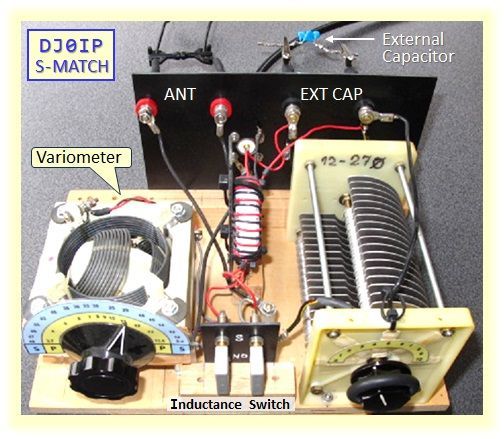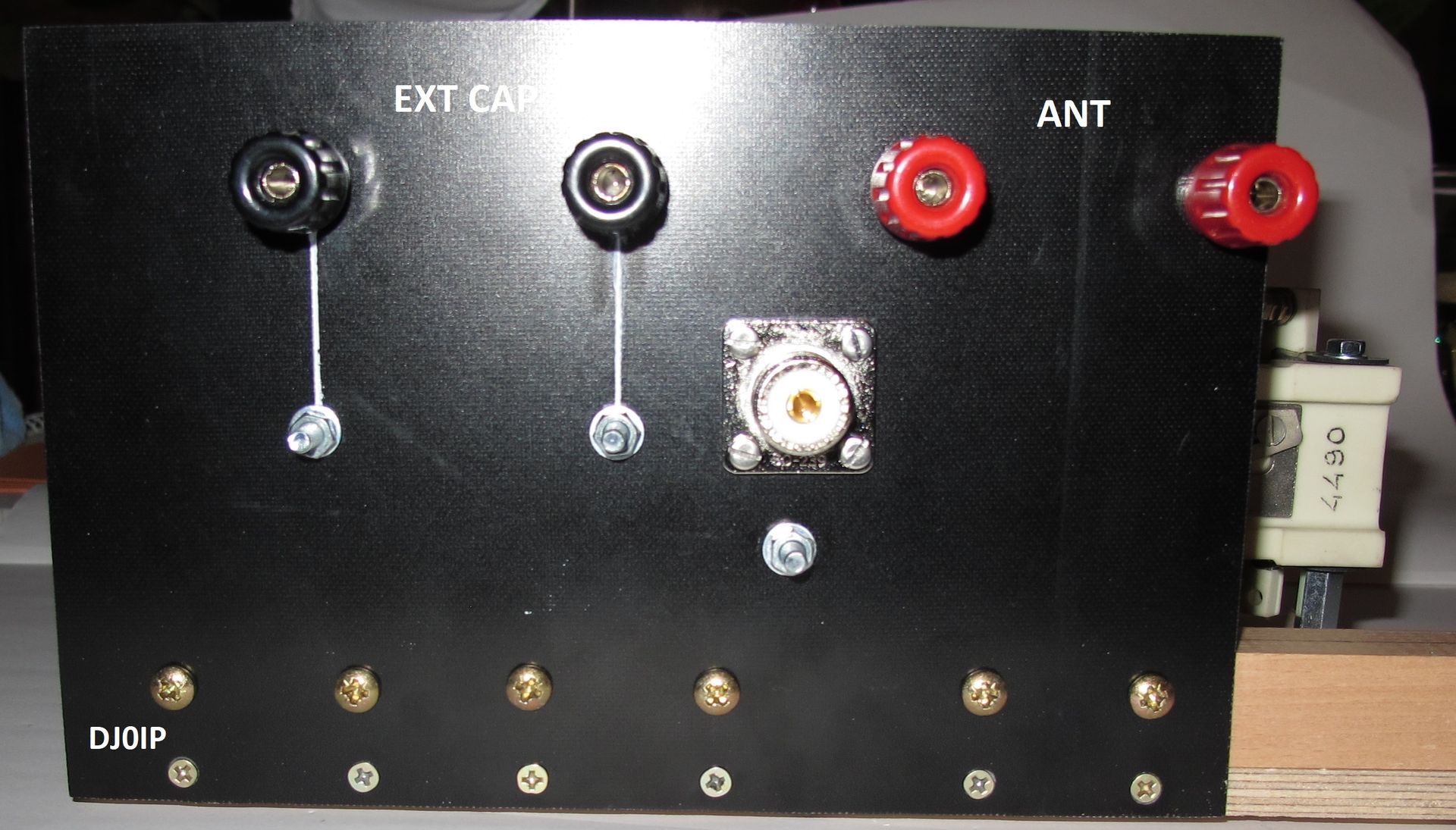S-MATCH SHOOTOUT
The "S-Match" tuner technology is a relatively new matchbox technology, created by Frits Geerligs, PA0FRI (SK). Link: PA0FRI.com
Many OM praise this as the "non-plus-ultra" tuner technology. BUT IS IT REALLY?
This simple matchbox comparison Shootout was my attempt to find out. I compared it to several popular antenna matchboxes with different technologies. (See "Results" chart below.)
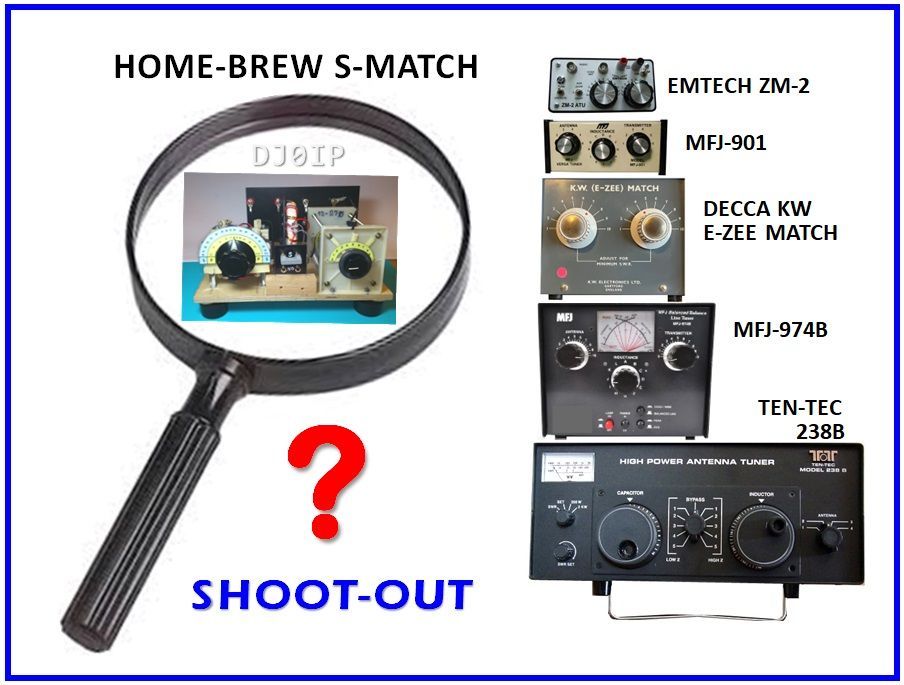
Since the S-Match is not available commercially, I had to build my own. Following a design on the PA0FRI web page, I chose to use a Variometer, rather than a Roller-Inductor.
The variometer has two coils, one fixed the other rotatable. They may be switched in series (9 to 48 uH) or in parallel (2 to 12 uH). Series was required on 80m. Parallel was used on all other bands.
Rather than using a variable capacitor with high pF, I chose to use a 270 pF variable and add additional capacitance to terminals on the back panel.
THE ANTENNA:
- Center-Fed INV-V Antenna, 18m Long
- Fed with 20.9 meters of 450 Ohm Ladder-Line (about 70 ft.)
I had this antenna in my junk box. It had been used 15 years ago as a short center-fed vertical dipole, mounted on an 18m Spiderbeam fiberglass pole, elevated 5m above ground.
I chose this for two reasons: 1) I already had it, and 2) Matching short antennas is more difficult than matching long antennas.

Native Impedances (by band)
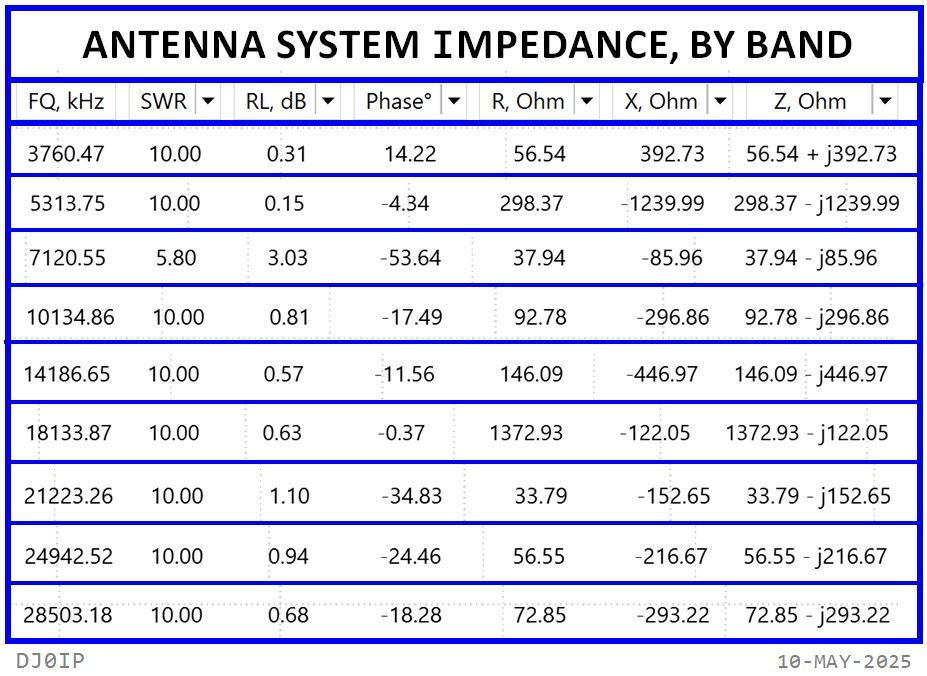
Measured with a dual-banana jack to BNC adapter connected through a BNC-to-N Adapter, directly to a RigExpert AA-230 ZOOM antenna analyzer.
Measurements were viewed in RigExpert "AntScope-2" software and the results (by band) were merged with PowerPoint into this chart.
Results (by band)
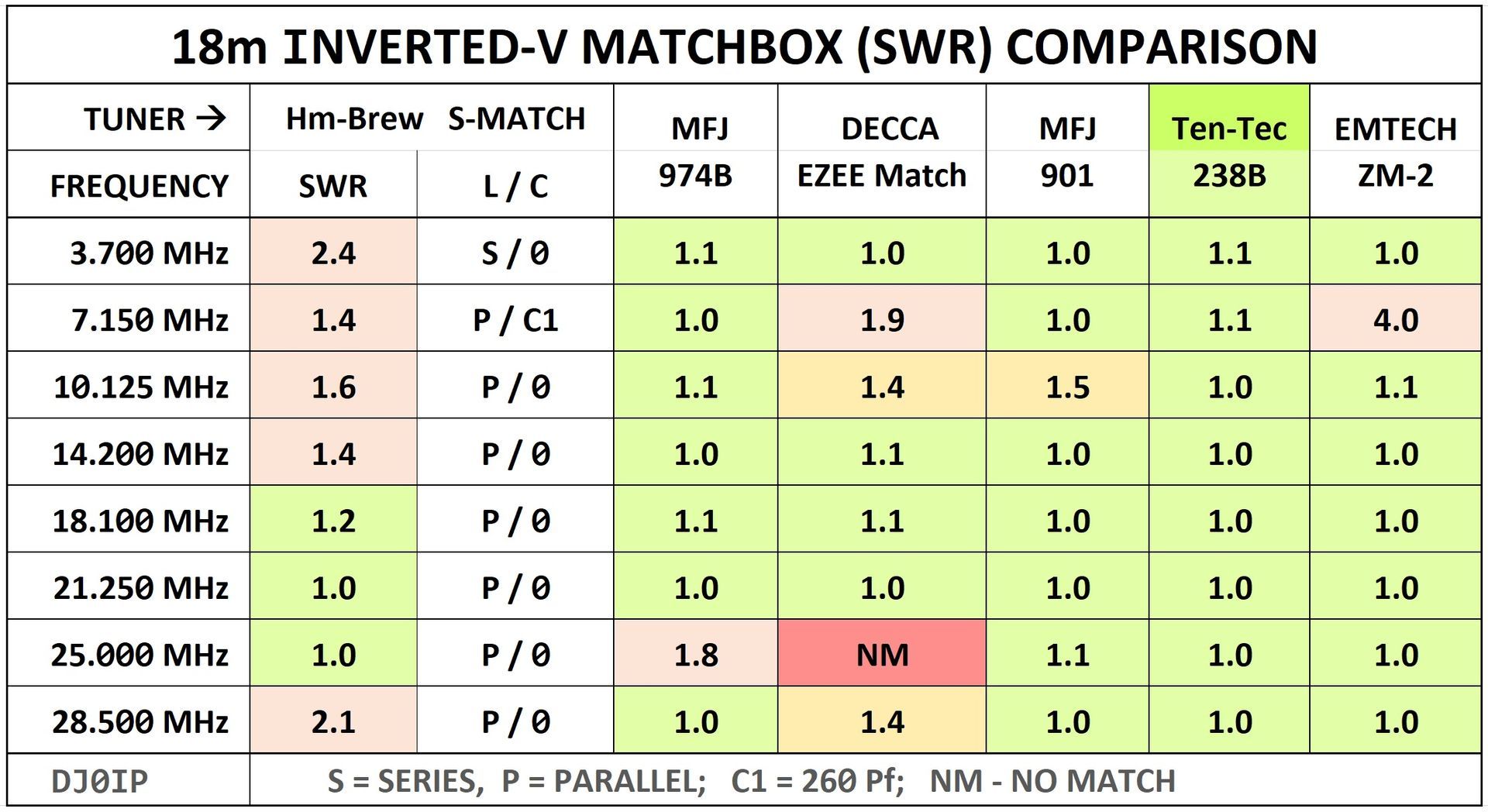
Matchbox Technology:
- Balanced-T: MFJ-974B
- Z-Match: DECCA KW EZEE Match, EMTECH ZM-2
- T-Match: MFJ-901
- L-Match: TEN-TEC Model 238-B
- S-Match: DJ0IP Home-Brew S-Match
A good mix of various matchbox technologies!
THE BALUN:
Both Asymmetrical tuners (901 & 238B) have a built-in 4:1 Voltage Balun. These are worthless!
I built a simple 1:1 Guanella Choke-Balun made of 12 turns of twisted pair (#18 AWG), wound on an FT-140-43, to use with the two unbalanced tuners.
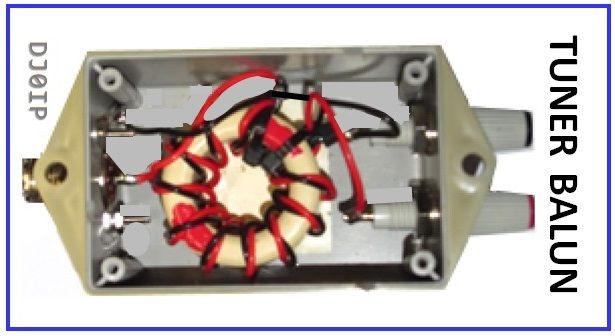
WINNERS AND LOOSERS:
Obviously, this is both Objective and Subjective.
- The objective can be read from the chart; The TEN-TEC won.
- To understand the subjective, you would have to have been sitting beside me.
The TEN-TEC won by a country mile!
Continuing with "Objective:
- The TEN-TEC 238-B
- The MFJ-901 was a close second place
- The MFJ-974B (best symmetrical tuner), was excellent except on 12m where it was "OK".
- The ZM-2 was 'almost' Outstanding, but had 4:1 SWR on 40m (my favorite band)
5a. The E-ZEE Match was "OK" certainly useable (except for 12m), but higher SWR on some bands.
5b. The S-Match was ok on most bands, but over 2:1 on 2 bands
The S-Match and E-ZEE Match are tied for last place. The order will depend on one's personal preferences.
Now the Subjective Reasons for the Ranking:
As tuning can be quite sensitive, "ease of tuning" is high on my list of subjective advantages. The next four bullets list things that make tuning difficult.
- Tuning is sometimes quite sharp/critical, making it difficult to reach the optimum position of the capacitor(s). Use of a 4:1 Vernier drive greatly reduces this problem (if it is a good Vernier with no slop in its drive). Unfortunately, it is rare that any but the most expensive tuners have this feature.
- "Tiny Knobs" make finding the optimum setting difficult. Often, you need to move the knob 1/2 mm left or right, but when you move it as carefully as you can, it jumps 1mm - which is past the optimum position. It often took 5 or 6 attempts (back and forth) to obtain minimum SWR.
- "Slop in the Adjustment": Similar to above, but this can occur, even when you have a Vernier and larger knobs. This is when you are tuning in one direction, then change directions; you turn the knob for the first few few mm, but the capacitor does not move. Then suddenly it begins to move and you tune too far - past the optimum setting. The E-ZEE Match has this problem.
- "Hand Effect" (for lack of a better name); meaning when I grasp the knob, the setting changes, or when I tune to the optimum setting, then let go of the knob, the match changes. As a result, it takes several attempts (trial and error) to finally achieve the proper setting.
COMMENTS ON EACH TUNER:
1) TEN-TEC MODEL 238-B (L-Network):
In my subjective opinion, this tuner was MUCH easier to tune than any of the others. It has a large 55mm (<2 in.) tuning knob on its capacitor and roller inductors are always easy to adjust.
On average, it achieved the lowest match of any of the tuners, obtaining 1.1:1 or 1.0:1 on all bands.
Of course, it was also the most expensive tuner in the test group.
Side Note: the 238-B has a 500 pF variable capacitor, plus 4 switched-in "padding" fixed capacitors, 440 pF each. This totals 2260 pF maximum capacitance. In addition, there is provision on the back panel for manually attaching an external capacitor. A 1000 pF disc ceramic capacitor comes with the tuner, for a maximum of 3260 pF capacitance. In the 25+ years that I have used this tuner, I have only had to add capacitance to the back two time; both times were on very short low-band antennas.
- - - - - - - - - - - - - - - - - - - - - - - - - - - - - - - - - - -
2) MFJ-901 (T-Network):
This 45 year old tuner is a simple tuner with input and output capacitors are 208 pF. It has a tapped, switched air-core inductor. Its built-in 4:1 voltage balun is worthless. Don't use it.
Its SWR on all bands is
1.1:1 or
1.0:1,
except for 30m where it is 1.5:1.
At first glance, it seems to be nearly just as good as the TEN-TEC.
Unfortunately, it suffers from Three of the four issues mentioned above: No Vernier drive, Tiny Knobs, & Hand-Effect. Replacing its capacitors' knobs with larger plastic knobs improves ease of tuning.
- - - - - - - - - - - - - - - - - - - - - - - - - - - - - - - - - - -
3) MFJ-974B (Balanced-T):
This is a balanced version of the MFJ-901, having two 208 pF variable capacitors on each side of its Roller Inductor. It had achieved an excellent match (1.1:1 or 1.0:1) on all bands except 12m where it had 1.8:1. Tuning was sometimes difficult due to no Vernier drive on its capacitors.
Side Note: I have had this tuner or its predecessor (MFJ-974) for over 20 years and compared it often to the little 275 Watt Johnson Viking Matchbox - usually on 80m doublets at Field Day. Whereas the 974 always found a match, no problem, with the Johnson we often had to add more 450 Ohm Window line to bring in a missing band or two.
- - - - - - - - - - - - - - - - - - - - - - - - - - - - - - - - - - -
4) EMTECH ZM-2 (QRP Z-MATCH)
As stated earlier, this tiny tuner was outstanding on all bands (1.1:1 or 1.0:1) except 40m, where its SWR only achieved 4:1.
Unfortunately its Tiny Knobs and no Vernier drive made tuning quite difficult on some bands.
Side Note: Its big lighted Watt/S Meter eliminates the need for taking an additional external meter on outings. On motorcycle trips, I always took the MFJ-901 but when traveling by car or RV, I always preferred the MFJ-974. Although the MFJ-901 has the same matching ability, the 974 is much easier to tune.
- - - - - - - - - - - - - - - - - - - - - - - - - - - - - - - - - - -
5) DECCA KW E-ZEE MATCH (Z-Match):
The Z-Match had a relatively poor showing in average SWR compared to the others, but was still quite usable except on 12m, where it was unable to find a match. Otherwise, it achieved an SWR of under 2:1.
Unlike other technologies, there is no variable coil in a Z-Match. It is adjusted with two variable capacitors. However, it has two pairs of antenna connectors; one for 80/40m and one for 20-10m.
When the WARC bands were allocated, the connection on 30m depended on the specific antenna. It could be either one of the to outputs.
Although the E-ZEE Match has a 4:1 Vernier drive on one of its capacitors, it has too much "slop in the drive", making it difficult to adjust on some bands. When changing directions, it was necessary to rotate the knob about 30 degrees before it began to change capacitance.
Side Note: Outside of the U.S., where the Johnson Viking was popular, the Z-Match has been an early favorite symmetrical matchbox for at least 75 years. At one time there were several U.S. companies building S-Match tuners. Though quite efficient over a broad midrange of impedance, it has somewhat higher loss on high and low impedance extremes.
The
slop in the Vernier was not unique to my unit. I have had the unit for 40 years and for many years also had a second unit - one for portable and one for the home station. Both had this problem. I have used all sorts of balanced antennas with these; horizontal and vertical loops, horizontal and vertical dipoles, etc. I have always been able to match every antenna at every location, albeit, like with the Johnson Viking, I sometimes had to adjust the feedline length.
Like the Johnson Viking, a Z-Match has a fair amount of bandpass filtering. This was beneficial for old receivers in the 50s/60s/70s/80s where the 3rd order Dynamic Range (DR3) was in the 50 db range, gradually improving to abut 80 dB. Todays typical DR3 of most radios is 90 to 110 dB, making this feature no longer necessary. However, I use my Z-Match as a pre-selector for my SDRplay receiver, which has no front-end bandpass filters.
- - - - - - - - - - - - - - - - - - - - - - - - - - - - - - - - - - -
6) Home-Brew S-MATCH:
The S-Match was a big disappointment, at least on THIS specific antenna. It only achieved low SWR (1.1:1 or 1.0:1) on 12 and 10m. On a couple bands its was very "wishy-washy", meaning I could turn the Variometer from minimum to maximum without much influence on the SWR. Obviously its efficiency is anyone's guess on bands where that occurs.
The ergonomics are good on some bands, but there was a bit of "Hand Effect", though not as bad as on the 901 and ZM-2. This resulted in needing several attempts to find the correct position.
Side Note: Since there is no commercial source for the S-Match, each and every S-Match is unique, and will be different from the others. I personally find it pointless to build one. There are low-cost T-Network tuners that will match balanced-line antennas just as well, using an external 1:1 balun. Read more in the
"DISCUSSION" below.
DISCUSSION:
Balanced-Line fed antennas may have an impedance presented to the tuner that is anywhere between 10 Ohms (or even less), up to a few thousand Ohms - depending on the type of antenna, length of antenna, height of antenna, and the length and impedance of the balanced feedline.
So making a comparison on just one specific antenna is NOT an indication of how the S-Match compares in general to other tuners.
Further, measuring only the impedance match (SWR) is not a full story of how well the tuner is working. We need to compare the amount of RF Current, Balance, and Phase transferred to the feedline.
However, if we don't achieve a good match, the other three parameters are meaningless.
THE primary goal of this tuner "Shootout" was to see how well my S-Match compares to several other tuner technologies in matching a typical (short) balanced antenna. Here in Europe, many if not most OM are forced to use short antennas due to the limited space available.
In the past 15 years I have only heard people bragging about how well their S-Match performs; how they prefer it over all other types of tuners. Yet seldom do any of these OM tell us what type(s) of antenna they use it with and what other tuner technologies they compared it with... and they never give any measured data.
HERE are a couple of statements which bear more credibility:
RadCom tested a home-brew S-Match in their September 2008 issue, pages 121 & 122. The author measured efficiency on all bands, comparing it to the MFJ-901B, MFJ-989C and MFJ-974 tuners. The S-Match measured somewhat lower efficiency than the others.
PA0FRI (the creator of the S-Match) wrote “The efficiency is a little less than with a LC system using two capacitors and one inductor, but in practice, the difference is minimal”.
My Opinion (for what it's worth):
The S-Match is relatively new compared to other technologies, and it certainly works well for some people with some antennas. There doesn't appear to be any specific measured data comparing it to other technologies for SWR and the Amount, Balance and Phase of the RF transferred to the feedline.
However, considering you must build your own, the cost of components, the amount of time, and that most people do not have the means (or knowledge) to evaluate the efficiency of the S-Match, I find it preferable to simply buy an antenna matchbox (new or used) that we "know" will work.
I believe most of the people praising the S-Match are people still believing that a balanced antenna fed with balanced feedline is best matched with a balanced antenna tuner.
NOTHING COULD BE FARTHER FROM THE TRUTH!
There have been several test of matching balanced antenna with various tuner and in none of them did any balanced tuner fair better than other technologies. I have 4 such "SHOOTOUTS" published on my web site. Probably the one with the most credibility was conducted by Tom Rauch, W8JI.
You will find links to these Shootouts, here: https://www.dj0ip.com/ant-tun-sh-outs
CONCLUSION:
I concur with Karl Hille, DL1VU (SK), Owen Duffey, VK1OD, and Tom Rauch, W8JI, that the best way to feed a balanced antenna fed with balanced feedline is with a "good" asymmetrical (un-balanced) antenna tuner, such as a T-Network or L-Network together with an external 1:1 Guanella (current) choke-balun mounted in a non-conducting enclosure. (Or no enclosure at all.)
There are many symmetrical (balanced) tuners that are very good and work just as well most of the time, but they are more complex and more expensive.
- There are also "balanced (?)" tuners that do not work quite as well because the construction itself is not perfectly balanced. This has been shown in matchbox shootouts shown on my web. See links below.
With balanced antenna systems that are poorly balanced, the solution with an un-balanced tuner and external balun will do a better job of blocking Common Mode Current than the balanced tuners.
- This is the case with vertical dipoles fed with balanced-line, where the lower half of the dipole is closer to the ground than the upper half. And this is one of my favorite DX antennas of all!
- It can also occur when one of the legs of the antenna runs over a metal roof, or when the feedline itself runs radically skewed to one side, rather than perpendicular to the antenna.
I see no advantage in using a balanced tuner today for matching balanced-line fed antennas.
LINKS to Other Matchbox Shootouts:
1) ARRL MATCHBOX SHOOTOUTS:
- https://www.dj0ip.com/arrl-tuner-test (unbalanced tuners)
2) DL2BC's Balanced-Line Tuner Shootout:
3) KD7MW's Matchbox Shootout on Balanced-Line Fed Antennas
4) WB6BYU's Antenna Tuner Efficiency Ratings
5) W8JI's Comparison Test: Johnson Viking Matchbox vs. Transmatch
- Tom compares the popular J. Viking Matchbox to an very good T-Network matchbox using both its internal and an external balun. THIS should open the eyes of those still living in the past!


